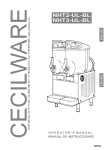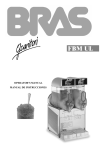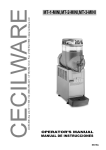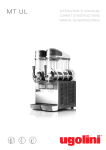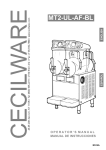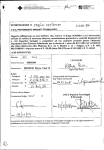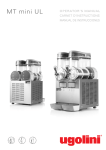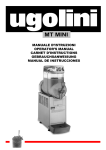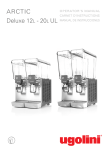Download Cecilware NHV-2-UL Operator`s manual
Transcript
ESPAÑOL ENGLISH ENGLISH NHV UL OPERATOR’S MANUAL MANUAL DE INSTRUCCIONES NS08A NHV UL 1 TECHNICAL CHARACTERISTICS ........................................................................................................................ 4 2 INTRODUCTION .................................................................................................................................................... 4 3 INSTALLATION ...................................................................................................................................................... 4 4 TO OPERATE SAFELY ......................................................................................................................................... 5 5 OPERATING PROCEDURES ................................................................................................................................ 5 5. 1 DESCRIPTION OF CONTROLS .................................................................................................................. 5 5. 2 OPERATION HELPFUL HINTS ................................................................................................................... 6 5. 3 CLEANING AND SANITIZING PROCEDURES ........................................................................................... 7 5. 3. 1 DISASSEMBLY ............................................................................................................................... 7 5. 3. 2 CLEANING ...................................................................................................................................... 8 5. 3. 3 SANITIZING ..................................................................................................................................... 9 5. 3. 4 ASSEMBLY ..................................................................................................................................... 9 5. 4 IN-PLACE SANITIZATION ......................................................................................................................... 10 5. 5 REAR SEAL MAINTENANCE .................................................................................................................... 10 6 ROUTINE MAINTENANCE .................................................................................................................................. 10 6. 1 MAINTENANCE (TO BE CARRIED OUT BY QUALIFIED SERVICE PERSONNEL ONLY) ..................... 11 7 DEFROST TIMER (OPTIONAL) .......................................................................................................................... 11 ENGLISH INDICE GENERALE INDICE GENERAL 1 CARACTERISTICAS TECNICAS ....................................................................................................................... 12 2 INTRODUCCION ................................................................................................................................................. 12 3 INSTALACIÓN ..................................................................................................................................................... 12 4 PARA UN FUNCIONAMIENTO SEGURO ........................................................................................................... 13 5 INSTRUCCIONES DE EMPLEO ......................................................................................................................... 5. 1 DESCRIPCION DE LOS MANDOS ........................................................................................................... 5. 2 SUGERENCIAS ......................................................................................................................................... 5. 3 LIMPIEZA ................................................................................................................................................... 5. 3. 1 DESMONTAJE .............................................................................................................................. 5. 3. 2 LAVADO ........................................................................................................................................ 5. 3. 3 HIGIENIZACION DEL DISTRIBUIDOR DESMONTADO .............................................................. 5. 3. 4 REMONTAJE ................................................................................................................................. 5. 4 HIGIENIZACION DEL DISTRIBUIDOR MONTADO .................................................................................. 5. 5 MANTENIMIENTO JUNTA POSTERIOR ................................................................................................... 6 MANUTENCION .................................................................................................................................................. 18 6. 1 MANUTENCION (SOLAMENTE POR EL SERVICIO POSTVENTA) ........................................................ 18 7 CONTADOR DE DESCONGELACION (OPCIONAL) .......................................................................................... 19 ESPAÑOL ENGLISH 13 13 14 15 15 16 16 17 18 18 This dispenser is manufactured under one or more of the following U.S.patents and/or other pending patents: Este aparato está cubierto por una o varias de las siguientes patentes y/o otras solicitudes de patente ya registradas: U.S.A. 4,696,417 U.S.A. 5,906,105 3 NHV UL 1 TECHNICAL CHARACTERISTICS NHV 2 UL and keep them for possible future use. Transparent removable bowls n 2 Gal 2.5 width Inches 14.25 depth Inches 18.25 height Capacity of each bowl, approx. Dimensions: Inches 27.75 Net weight, approx. Lbs 137 Gross weight, approx. Lbs 148 Adjustable thermostats n 2 Hermetic compressor n 2 Air-cooled condenser n 2 Overload protector n 2 Safety pressure switch n 2 Noise level lower than 70 dB (A) IMPORTANT Read electrical ratings written on the data plate of the individual units; the data plate is adhered on the dispensing side panel of the unit, just behind the drip tray (the right side drip tray in multiple bowl models). The serial number of the unit (preceded by the symbol #) is adhered inside the left switch box. Data plate specifications will always supersede the information in this manual. The electric diagram of the dispenser is located in the inner part of the dispensing side panel. Specifications are subject to change without notice. 2 INTRODUCTION Please read all sections of this manual thoroughly to familiarize yourself with all aspects of the unit. Like all mechanical products, this machine will require cleaning and maintenance. Besides, dispenser working can be compromised by operator’s mistakes during disassembly and cleaning. It is strongly recommended that personnel responsible for the equipment’s daily operations, disassembly, cleaning, sanitizing and assembly, go through these procedures in order to be properly trained and to make sure that no misunderstandings exist. 3 INSTALLATION 1 - Remove the corrugate container and packing materials 4 IMPORTANT When handling the machine never grasp it by the bowls or by the evaporator cylinders. The manufacturer refuses all responsibilities for possible damages which may occur through incorrect handling. 2 - Inspect the uncrated unit for any possible damage. If damage is found, call the delivering carrier immediately to file a claim. 3 - Install the unit on a counter top that will support the combined weight of dispenser and product bearing in mind what is stated in the preceding point 1 IMPORTANT warning. 4 - A minimum of 15 cm (6”) of free air space all around the unit should be allowed to guarantee adequate ventilation. 5 - Ensure that the legs are screwed tightly into the base of the machine. Replace the standard legs originally installed with the 100 mm (4”) legs whenever they are provided with the unit. 6 - Before plugging the unit in, check if the voltage is the same as that indicated on the data plate. Plug the unit into a grounded, protected single phase electrical supply according to the applicable electrical codes and the specifications of your machine. When the unit has no plug, install a proper grounded plug, in compliance with electrical codes in force in your area, suitable to at least 10 Amp 250 Volt (220-230 Volts 50-60 Hz areas) and 20 Amp 25 0 Vol t (1 00-1 15 Vol ts 5 0-6 0 Hz area s) applications. Should you prefer to connect the unit directly to the mains, connect the supply cord to a 2-pole wall breaker, whose contact opening is at least 0.125”. Do not use extension cords. ATTENTION Failure to provide proper electrical ground according to applicable electrical codes could result in serious shock hazard. 7 - The unit doesn’t come presanitized from the factory. Before serving products, the dispenser must be disassembled, cleaned and sanitized. according to this handbook instructions (chapter 5.3 CLEANING AND SANITIZING PROCEDURES). 4 TO OPERATE SAFELY 1 - Do not operate the dispenser without reading this operator’s manual. 2 - Do not operate the dispenser unless it is properly grounded. 3 - Do not use extension cords to connect the dispenser. 4 - Do not operate the dispenser unless all panels are restrained with screws. 5 - Do not obstruct air intake and discharge openings: 15 cm (6”) minimum air space all around the dispenser. 6 - Do not put objects or fingers in panels louvers and faucet outlet. 7 - Do not remove bowls, augers and panels for cleaning or routine maintenance unless the dispenser is disconnected from its power source. NHV UL 5 OPERATING PROCEDURES in switch panels protected by switch covers (see figure 1). ATTENTION 1 - Clean and sanitize the unit according to the instructions in this manual. See chapter 5.3 CLEANING AND SANITIZING PROCEDURES. 2 - Fill the bowls with product to the maximum level mark. Do not overfill. The exact quantity of product (expressed as liters and gallons) is shown by marks on the bowl. 3 - In case of products to be diluted with water, pour water into bowl first, then add correct quantity of product. In case of natural particulates, it is advisable to strain them, in order to prevent pulps from obstructing the faucet outlet. 4 - To obtain the best performance and result, use bases designed to be run in Granita freezers. Such bases have a sugar content of 34 degrees Baumé corresponding to 64 degrees Brix. For soft drinks the bases are to be diluted with more water, on a 1 plus 5/5.5 basis. In any case follow the syrup manufacturer’s instructions for both Granita and soft drink recipes. If natural juices (e.g. lemon, orange) as well as sugarless products (e.g. coffee) are used, dissolve 5.3 - 7 oz. of sugar per 0.25 gallons. figure 1 With reference to figure dispenser controls functions are as follows (see figure 2): figure 2 IMPORTANT However Granita mix may be done, its Brix (sugar percent content) must be at least 13. Power switch (A) 0 position : I position : IMPORTANT Operate the dispenser with food products only. 5 - Install the covers and check that they are correctly placed over the bowls. The dispenser must always run with the covers installed to prevent a possible contamination of the product. 6 - Set the control switches as shown in chapter 5.1 DESCRIPTION OF CONTROLS. 7 - Always leave the dispenser on, as the refrigeration stops automatically when Granita reaches the proper thickness. The mixers will continue to turn. 5. 1 DESCRIPTION OF CONTROLS The dispenser is equipped with a power switch and a light switch. In addition each bowl is individually operated by a mixer/refrigeration switch. In fact it is possible to dispense both soft drinks and Granita. When a bowl is in Soft Drink mode the beverage temperature is controlled by the corresponding thermostat. When a bowl is in Granita mode the mix viscosity is controlled by the corresponding adjustment screw located in the rear wall of each container (for temperature and viscosity setting make reference to chapter 5.2 OPERATION HELPFUL HINTS). All the switches are located on the faucet side of the dispenser ENGLISH In case of damages, the power cord must be replaced by qualified personnel only in order to prevent any shock hazard. Light switch (E) 0 position : I position : power is turned OFF to all functions. power is turned ON to all functions and the other switches are enabled. The fan motor runs. all top cover lights are OFF. all top cover lights are ON, provided that power switch (A) is set to I. Mixer/refrigeration switch (B) I position : mixer and refrigeration ON. SOFT DRINK mode. 0 position : OFF. II position : mixer and refrigeration ON. GRANITA mode. Thermostat (D) Turn clockwise Turn counterclockwise : to decrease temperature : to increase temperature To operate the unit: 1 - Set the power switch to I position. 2 - Set the mixer/refrigeration switches as follows: - to the I position to get soft drink. - to the II position to get Granita. 3 - Set the light switch to I position. 5 NHV UL 5. 2 OPERATION HELPFUL HINTS at the start of each day. 1 - Granita viscosity adjustment: proper Granita viscosity is 7 - For good product conservation the dispenser must run factory preset. To change the viscosity, if needed, use a overnight, at least in Soft Drink mode. standard screwdriver to turn the adjustment screw located If this is not possible and product is left in the bowls in the rear wall of each container as follows (see figure 3): overnight, the mixer/refrigeration switches must be set to - towards right (clockwise) to obtain a thicker product (the the I position at least one hour before the unit is switched indicator F will go down in opening G). off. This eliminates any block of iced product forming - towards left (counterclockwise) to obtain a thinner overnight, which could result in damage to mixers or to product (the indicator F will go up in opening G). their motor when the unit is switched back on. In any case, before the unit is restarted, make sure that no blocks of ice have been formed; if so, they are to be removed before the unit is switched on. Overnight operation in drink mode also eliminates possible ice accumulation from condensation all around the bowls. 8 - Mixers must not be turned off when frozen product is in the bowl: if not agitated, the product may freeze to a solid block of ice. If the mixers are turned back on in this situation, damage to the mixers and their motor may result. Therefore, mixers may be restarted only after product is melted. figure 3 9 - The dispenser must be able to emit heat. 2 - Beverage temperature adjustment: proper beverage In case it seems excessive, check that no heating source temperature is factory preset. To reset, turn the knob is close to the unit and air flow through the slotted panels is located in each switch box as follows: not obstructed by wall or boxes. Allow at least 15 cm (6”) of - towards right (clockwise) to decrease temperature. free clearance all around the dispenser. - towards left (counterclockwise) to increase temperature. In any case if the product in the bowls is frozen and the Note: beverage temperature is controlled by the safety pressure switch warning light is OFF the unit is t h e r m o s t a t o n l y w h e n t h e mi x e r / r e f r i g e r a t i o n running properly. switch(es) are in I position, Soft Drink mode. 10 -Restrictor cap: when the unit is used in Soft Drink mode it 3 - When the mixer / refrigeration switch(es) are set in I position, Soft Drink mode, it is possible to manually switch is advisable to install the restrictor cap on the faucet outlet in order to reduce the drink outflow (see figure 4). off the refrigeration by turning completely towards left (counterclockwise) the thermostat knob until it clicks. 4 - The length of time for freeze down of Granita is governed by many variables, such as ambient temperature, mix initial temperature, sugar content (Brix level) and viscosity setting. 5 - To shorten Granita recovery time and increase productivity, it is advisable to pre-chill the product to be used in the dispenser. 6 - To shorten Granita recovery time and increase productivity, the bowl should be refilled after the product level drops lower than half of the evaporator cylinder and 6 figure 4 NHV UL 5. 3 CLEANING AND SANITIZING PROCEDURES 1 - Cleaning and sanitizing of the dispenser are recommended to guarantee the conservation of the best ENGLISH product taste and the highest unit efficiency. This section is a procedural guideline only and is subject to the requirements of the local Health Authorities. 2 - Prior to the disassembly and cleaning, the machine must be emptied of product. To do this proceed as follows: - set the power switch to I position - set mixer/refrigeration switch(es) to I position (Soft Drink figure 6 mode) - place a pail under each faucet and drain all product from bowls 3 - Slide the outer spiral out (see figure 7) and then the inside auger. Frequently remove the rear seal by sqeezing it to break the suction grip (see figure 8). - set all control switches to the 0 position. 5. 3. 1 DISASSEMBLY ATTENTION Before any disassembly and/or cleaning procedure make sure that the dispenser is disconnected from its power source. 1 - Remove cover from the bowl. 2 - Remove the bowl by lifting its faucet side up and off the fastening hooks (see figure 5) and slide it out (see figure figure 7 6). figure 5 figure 8 7 NHV UL 4 - Remove the bowl gasket from its seat (see figure 9). dishwashing detergent. Do not use abrasive detergent. Important: if present, follow label directions, as too strong a solution can cause parts damage, while too mild a solution will not provide adequate cleaning. IMPORTANT In order to prevent any damages to the dispenser use only a detergent suitable with plastic parts. 2 - Using a brush, suitable for the purpose, thoroughly clean all disassembled parts in the cleaning solution. ATTENTION figure 9 5 - Dismantle the faucet assembly (see figure 10). When cleaning the machine, do not allow excessive amounts of water around the electrically operated components of the unit. Electrical shock or damage to the machine may result. 3 - Do not immerse the lighted top covers in liquid. Wash them apart with the cleaning solution. Carefully clean their undersides. 4 - In the same manner clean the evaporator cylinder(s) using a soft bristle brush. 5 - Rinse all cleaned parts with cool clean water. 5. 3. 3 SANITIZING Sanitizing should be performed immediately prior to starting the machine. Do not allow the unit to sit for extended periods of time after sanitization. 1 - Wash hands with a suitable antibacterial soap. 2 - Prepare at least two gallons of a warm (45-60 °C / 120140 °F) sanitizing solution (100 PPM available chlorine concentration or 1 spoon of sodium hypoclorite diluted with figure 10 6 - Slide the drip tray out and empty it. half a gallon of water) according to your local Health Codes and manufacturer’s specifications. 3 - Place the parts in the sanitizing solution for five minutes. 5. 3. 2 CLEANING ATTENTION Before any disassembly and/or cleaning procedure make sure that the dispenser is disconnected from its power source. IMPORTANT Do not attempt to wash any machine components in a dishwasher. 1 - Prepare at least two gallons of a mild cleaning solution of warm (45-60 °C / 120-140 °F) potable water and 8 4 - Do not immerse the lighted top covers in liquid. Carefully wash their undersides with the sanitizing solution. 5 - Place the sanitized parts on a clean dry surface to air dry. 6 - Wipe clean all exterior surfaces of the unit. Do not use abrasive cleaner. 5. 3. 4 ASSEMBLY 1 - Slide the drip tray into place. 2 - Lubricate faucet piston, inside auger and outer spiral (see points A, B and C) (see figure 11) only with the grease supplied by the manufacturer or other food grade NHV UL front notch engages with the exposed end of the auger shaft (see figure 14). ENGLISH approved lubricant. figure 11 3 - Assemble the faucet by reversing the disassembly steps (see figure 10) 4 - Fit bowl gasket around its seat. Note: the largest brim of gasket must face against the rear wall (see figure 12). figure 14 7 - Push the bowl towards the rear wall of the unit until it fits snugly around the gasket and its front fastening hooks are properly engaged (see figure 15). figure 15 figure 12 5 - Insert the auger into the evaporator. Taking care to insert the rear seal properly. (see figure 13). 8 - Use fresh product to chase any remaining sanitizer from the bottom of the bowl(s). Drain this solution. Do not rinse out the machine. 5. 4 IN-PLACE SANITIZATION The In-Place Sanitization prior to starting the machine may be performed, if needed, only as further precaution, in addition to the Disassembled Parts Sanitization described before, but never in lieu of it. 1 - Prepare two gallons of a warm (45-60°C / 120-140 °F) sanitizing solution (100 PPM available chlorine concentration or 1 spoon of sodium hypoclorite diluted with half a gallon of water) according to your local Health Codes and manufacturer’s specifications. figure 13 6 - Install the outer spiral. Slide it over the evaporator until its 2 - Pour the solution into the bowl(s). 3 - Using a brush suitable for the purpose, wipe the solution 9 NHV UL on all surfaces protruding above the solution-level and on the underside of the top cover(s). 4 - Install the top cover(s) and operate the unit. Allow the solution to agitate for about two minutes. Drain the solution 3 - Replacement of lighted top cover bulb: remove the fixing screw placed in the upper part of the top cover, remove the lower part and replace the bulb (using a 24-28V 21W max bulb). Reassemble the top cover and replace the fixing screw.(see figure 17) out of the bowl(s). 5 - Use fresh product to chase any remaining sanitizer from the bottom of the bowl(s). Drain this solution. Do not rinse out the machine. figure 17 5. 5 REAR SEAL MAINTENANCE IMPORTANT The rear seal, P.N. 00145 (Nr. 11 in the exploded view), must be kept lubricated, in the shaded rear area, with food grade approved lubrificant. To prevent from damages to the machine,it must be replaced every 2000 hours. To remove the rear seal sqeeze it to break the suction (see figure 16) ATTENTION Condenser fins are very sharp. Use extreme caution when cleaning. 6. 1 MAINTENANCE (TO BE CARRIED OUT BY QUALIFIED SERVICE PERSONNEL ONLY) 1 - Annually: remove the panels and clean the inside of the machine including the base, side panels, condenser, etc. 2 - Annually: Check if the auger bushings are worn out or ovalized. If they are, replace them with new ones. 3 - Never remove the insulating jacket from around the figure 16 suction tubing of the evaporator (the copper tubing located on the right side of gear motor). In case the insulating jacket is missing replace the entire parts with original 6 ROUTINE MAINTENANCE spare parts from the supplier. 4 - In order to prevent any damages to the dispenser, all IMPORTANT In order to prevent damages to the machine, the “Rear Seal” must be replaced every 2000 hours. 1 - Daily: inspect the machine for signs of product leaks past seals and gaskets. If proper assembly does not stop leaks around seals or gaskets, check for improper lubrication, worn or damaged parts. Replace parts as needed. 2 - Monthly on NHT 2 UL models: remove the dust from the condenser filter. A blocked filter will reduce performance ATTENTION plastics parts must be lubricated only with grease supplied by the manufacturer or with another lubricating product suitable for polycarbonate. IMPORTANT The electric diagram of the dispenser is located in the inner part of the dispensing side panel. 7 DEFROST TIMER The Defrost Timer, located on the right side of the unit, Before any disassembly and/or cleaning procedure make sure that the dispenser is disconnected from its power source by unplugging it or switching off the 2pole wall breaker. and could cause compressor failure. 10 automatically switches the dispenser from Granita mode to Soft Drink mode and the opposite. This means that during defrost periods frozen Granita will melt to thermostat setting temperature and once defrost period has expired, the product NHV UL ENGLISH automatically freezes down again to Granita setting viscosity. figure 18 To operate the defrost timer proceed as follows (see figure 18). 1 - Set the time of the day by rotating the dial clockwise (arrow A). Never rotate the timer counterclockwise as this would damage the internal mechanism. Align the current time of day with the arrow B on the timer face. This is a 24 hour timer showing both A.M. and P.M. 2 - Program the defrost timer by pushing out on the tabs C that correspond to the hours desired to defrost. Each tab represents 15 minutes. A minimum of four to eight hours are required to defrost frozen beverage (depending on ambient conditions). Note: when all the tabs are pushed in the defrost function is OFF (the machine operates as if it were not equipped with Defrost Timer). 11 NHV UL 1 CARACTERISTICAS TECNICAS NHV 2 UL si hubiera cualquier eventualidad. Contenedores transparentes desmontables n Capacidad aproximada de cada c o n t e n e d o r , Gal 2 2.5 Dimensiones: ancho Inches 14.25 largo Inches 18.25 alto Inches 27.75 Peso neto, aproximado Lbs 137 Peso bruto, aproximado Lbs 148 Termostatos regulables n 2 Motocompresor hermético n 2 Condensador a ventilación forzada n 2 Guardamotor n 2 Limitador de presión de seguridad n 2 Nivel de ruido inferior a 70dB (A) IMPORTANTE Características eléctricas: leer los datos detallados en la placa del distribuidor; ésta se encuentra en la parte inferior del panel frontal, detrás del cajón recoge-gotas de la derecha. Los números de matrícula de los aparatos (precedidos por el símbolo#) están colocados dentro del alojamiento portatinterruptores de izquierda. Los datos detallados sobre la placa son aquellos a los que se debe siempre hacer referencia. El diagrama eléctrico del distribuidor se encuentra dentro del panel lado grifo. Se reserva el derecho de efectuar modificaciones sin previo aviso. 2 INTRODUCCION Les aconsejamos que lean atentamente este manual de instrucciones para conocer todas las características del distribuidor. También este distribuidor, como todos los productos mecánicos, necesita de limpieza y cuidado. Se corre el riesgo de impedir su buen funcionamiento si se verificasen errores cometidos por el usuario durante la fase de desmontaje y limpieza. Por dicho motivo es importante que los procedimientos de desmontaje, lavado, higienización y limpieza, siendo operaciones cotidianas, sean conocidas sin posibilidad de error por todo el personal responsable del distribuidor. 3 INSTALACIÓN 1 - Quitar el distribuidor del embalaje: guardar este último por 12 IMPORTANTE En la operación de transporte o levantamiento no se debe coger nunca el distribuidor por sus contenedores transparentes o por los cilindros evaporadores. El fabricante no responde de los daños acarreados por estas maniobras equivocadas. 2 - Controlar que el distribuidor no haya sufrido daños durante el transporte. De haberlos sufrido, reclamar inmediatamente al transportista. 3 - Colocar el distribuidor en un mostrador en grado de sostener su peso incluso con la carga completa, teniendo en cuenta cuanto indicado en IMPORTANTE, del punto 1. 4 - Dejar un espacio libre de por lo menos 6” alrededor del aparato para no impedir el flujo de aire de refrigeración. 5 - Controlar la estabilidad del aparato, regulando la altura de los pies. En el caso en que el distribuidor esté provisto de una serie de piés altos (4” aproximadamente), ésta debe ser sustituida a la original. 6 - Antes de enchufar el aparato con la toma de corriente controlar que la tensión de la red sea aquella indicada en la placa. Enchufar el distribuidor a una red monofásica, sirviéndose de una toma completa de tierra, según lo previsto por la normativa vigente. Si el distribuidor resulta desprovisto de enchufe, conectar al cable un enchufe que esté en conformidad con las normas vigentes de vuestro país, provisto de espiga o contactos de tierra y adecuado para corrientes de por lo menos 10A y tensión de 250V (para áreas con tensiones de 220V-230V, 50Hz-60Hz) y 20 A y tensión de 250V (para áreas con tensiones de 110V-115V 50-60Hz). En el supuesto de realizar una conexión fija a la red, conectar el cable a un interruptor de pared de tipo bipolar con apertura de contactos de 0.125” por lo menos. No utilizar cordones conectores para enchufar el aparato al suministro de corriente eléctrica. ATENCION Cerciorarse que el aparato esté correctamente conectado a tierra; en caso contrario es posible causar shock eléctricos a las personas o dañar el distribuidor. 7 - El distribuidor no sale de fábrica prelavado e higienizado. Antes de utilizarlo debe ser desarmado, lavado e higienizado siguiendo cuanto se ha dicho en las presentes instrucciones del capítulo 5.3 LIMPIEZA. 4 PARA UN FUNCIONAMIENTO SEGURO 1 - No utilizar el distribuidor antes de haber leído el presente manual de instrucciones. 2 - No utilizar el distribuidor si no está correctamente conectado a tierra. 3 - No utilizar cordones conectores para enchufar el distribuidor al suministro de corriente. 4 - No poner en funcionamiento el distribuidor si los paneles no se encuentran en su lugar y fijados con los tornillos. 5 - No impedir el flujo de aire de refrigeración, dejar un espacio libre de por lo menos 15 cm alrededor del distribuidor. 6 - No introducir los dedos u objetos en las ranuras de los paneles y en la apertura del grifo. 7 - No desmontar el contenedor, no quitar los mezcladores o paneles para limpieza o manutención sin cerciorarse que el distribuidor esté desenchufado del suministro de corriente. NHV UL ATENCION Si el cable de alimentación está dañado, debe ser substituito por el fabricante o desde su servicio de asistencia técnica o, en cualquier caso, por una persona cualificada con el fin de evitar cualquier tipo de riesgo. 1 - Lavar e higienizar el distribuidor antes de utilizarlo siguiendo cuanto se ha dicho en las presentes instrucciones en el capítulo 5.3 LIMPIEZA. 2 - Llenar los contenedores con el producto deseado hasta que alcance el nivel máximo indicado (no superar dicho nivel). La cantidad de producto presente en el contenedor (en litros o en galones) está indicada con señales específicas situadas en el contenedor mismo. 3 - Si se quiere distribuir productos concentrados a diluirse con agua, verter en los contenedores el agua agregando a continuación la cantidad necesaria de producto concentrado, según las instrucciones del fabricante. Si se quieren emplear zumos naturales se recomienda filtrarlos para evitar que las partes sólidas puedan obstruir el pasaje del grifo. 4 - Para obtener los mejores resultados emplear como productos base, jarabes expresamente preparados para Granizado. Si se desea obtener una bebida en vez de un granizado, cada litro de jarabe debe ser diluido con 5-5,5 litros de agua (1 litro más respecto del necesario para el granizado). Es una buena regla seguir las instrucciones dictadas por el fabricante de jarabes. Si se usan productos naturales (por ejemplo zumo de limón o naranja) o bien bebidas no azucaradas (por ejemplo café), disolver 5.3 - 7 oz per 0.25 gallons de azúcar por cada litro de producto. posible obtener tanto bebidas frías como productos helados como granizados o sorbetes. Cuando se selecciona la función bebida, la temperatura de dicha bebida está regulada por el correspondiente termostato. Cuando se selecciona la función granizado la densidad del producto se regula con el correspondiente tornillo de ajuste que se encuentra en cada una de las paredes posteriores del distribuidor (para regular la temperatura y la densidad ver el capítulo 5.2 SUGERENCIAS). Todos los interruptores están colocados en la parte frontal del distribuidor (lado grifos) y están protegidos con una ventanilla apropiada (ver figura 1). figura 1 Las funciones de los mandos del distribuidor se ilustran a continuación (ver figura 2): ESPAÑOL ENGLISH 5 INSTRUCCIONES DE EMPLEO IMPORTANTE En todo caso, una vez obtenida la mezcla, su grado de Brix (porcentaje de azúcar) debe ser superior a 13. Interruptor general (A) Posición 0 : el distribuidor está apagado. IMPORTANTE Utilizar el distribuidor alimenticios. solamente con figura 2 productos 5 - Montar las tapas sobre los contenedores cerciorándose que queden bien colocadas y que se establezca una correcta conexión eléctrica entre el contenedor y la tapa. 6 - Accionar los interruptores (ver capítulo 5.1 DESCRIPCIÓN DE LOS MANDOS). 7 - El distribuidor debe funcionar siempre con las tapas montadas para prevenir una posible contaminación del producto. 8 - El distribuidor debe funcionar ininterrumpidamente: el sistema de refrigeración de cada contenedor se parará automáticamente cuando el producto esté listo para ser distribuido. Los dispositivos mezcladores seguirán funcionando. 5. 1 DESCRIPCION DE LOS MANDOS El distribuidor está provisto de un interruptor general y de un interruptor para la luz. Cada uno de los contenedores está provisto de un interruptor para arrancar la mezcla y para seleccionar el tipo de refrigeración del producto. En efecto, es Posición I : el distribuidor está habilitado para el funcionamiento. Ventilador en función. Interruptor luces (E) Posición 0 : luces tapa apagadas. Posición I : luces tapa encendidas. Interruptor mezcladores y refrigeración (B) Posición I : mezcladores y refrigeración en función. Posición BEBIDA. Posición 0 : mezcladores y refrigeración apagados. Posición II : mezcladores y refrigeración en función. Posición GRANIZADO. Termostato (D) Rotación en sentido horario : bebida más fría Rotación en sentido antihorario : bebida menos fría Para el funcionamiento del distribuidor: 13 NHV UL refrigeración en la posición I; ésto evita la formación de bloques o crostas de hielo que podrían dañar los dispositivos mezcladores. En el caso en que se formasen dichos bloques de hielo, estos deberían ser quitados antes de volver a poner en función el distribuidor. El funcionamiento nocturno en la posición Bebida elimina además la posible formación de hielo (debido a la condensación de la humedad atmosférica) en el exterior de los contenedores. 1 - Colocar el interruptor general en la posición I. 2 - Ajustar los interruptores mezcladores y refrigeración: - en la posición I si se quiere refrigerar el producto sin helarlo - en la posición II si se quiere obtener el granizado. 3 - Poner el interruptor luces en la posición I para encender las luces. 5. 2 SUGERENCIAS 1 - Regulación de la densidad: la densidad óptima del granizado ha sido ya ajustada en fábrica. Si se quiere variar dicha densidad girar con un destornillador el correspondiente tornillo de ajuste situado en cada una de las paredes posteriores del distribuidor (ver figura 3): - hacia derecha (sentido horario) para obtener un granizado más denso (el índice F en la ventanilla G se desplazará hacia abajo). - hacia izquierda (sentido antihorario) para obtener un granizado menos denso (el índice F en la ventanilla G se desplazará hacia arriba). 7 - No parar jamás los mezcladores cuando hay granizado en los contenedores; si no se mezcla, dicho granizado puede agregarse y formar un único bloque de hielo. Volviendo a arrancar los mezcladores en estas condiciones (sin esperar que el hielo se derrita) pueden dañarse. 8 - El distribuidor está provisto de una junta magnética para la transmisión del movimiento a los mezcladores.Para prevenir daños al aparato, en caso de bloqueo de los mezcladores debido a bloques de hielo u otro dentro de los contenedores, la junta magnética se encarga de desconectar automáticamente la transmisión del movimiento. Dicha situación puede ser identificada tanto por el bloqueo de los mezcladores como por un ruído intermitente que proviene del aparato. En este caso es necesario parar inmediatamente el distribuidor, vaciar el contenedor interesado y eliminar la causa del bloqueo. 9 - Reductor del flujo: cuando el distribuidor se utiliza para la refrigeración de bebidas se aconseja instalar, sobre el grifo, el reductor de flujo provisto (ver figura 4). figura 3 2 - Regulación de la temperatura: la temperatura óptima de las bebidas (para el funcionamiento del distribuidor como refrigerador de bebidas y no como granizador) ha sido regulada en la fábrica. Si se quiere variar su valor, girar el pomo colocado en cada una de los paneles portainterruptores: - hacia derecha (sentido horario) para obtener una bebida más fría. - hacia izquierda (sentido antihorario) para obtener una bebida menos fría. NOTA : la regulación de la temperatura de la bebida se hace efectiva solamente cuando el interruptor mezcladores y refrigeración correspondiente se encuentra en la posición Bebida. 3 - El tiempo necesario para obtener la refrigeración del producto varía en función de distintos factores como por ejemplo la temperatura ambiente, la temperatura inicial del producto, su contenido de azúcar (grado Brix) y la regulación de la densidad. 4 - Llenando los contenedores con producto ya enfriado previamente se aumenta ulteriormente la eficiencia del distribuidor. 5 - Para disminuir los tiempos de restablecimiento y, por lo tanto, aumentar la autonomía del distribuidor, volver a llenar cuando el nivel del producto desciende a mitad evaporador. 6 - Para conseguir una buena conservación del producto, el distribuidor debe funcionar también durante la noche, por lo menos en la posición Bebida. Si esto no fuera posible y los productos permanecieran en los contenedores con el distribuidor parado es conveniente, una hora antes de apagar el aparato, llevar los interruptores mezcladores y 14 figura 4 5. 3 LIMPIEZA 1 - La limpieza y el lavado son fundamentales para garantizar la perfecta conservación del gusto de la bebida y la máxima eficiencia de vuestro distribuidor. Los procedimientos descritos a continuación deben ser considerados de carácter general y pueden variar por efecto de la reglamentación de higiene vigente. 2 - Antes del desarmado para el lavado del distribuidor debe quitarse todo el producto. Proceder como sigue: - poner el interruptor general en la posición I; - poner los interruptores mezcladores/refrigeración en la posición I; - posicionar un recipiente debajo del grifo y vaciar los contenedores; - poner todos los interruptores en la posición 0. NHV UL 5. 3. 1 DESMONTAJE ATENCION Antes de proceder con el desmontaje de cualquier componente, desenchufar de la toma de corriente eléctrica el enchufe del aparato o bien apagar el interruptor externo de pared. 1 - Quitar la tapa del contenedor. 2 - Desmontar el contenedor empujando ligeramente la parte inferior (lado grifo) hacia arriba para dejar libres los figura 7 ganchos inferiores (ver figura 5) y luego quitarlo por figura 8 figura 5 4 - Quitar de su alojamiento la junta del contenedor (ver figura 9). figura 9 5 - Desarmar el grifo respetando la secuencia indicada (ver figura 6 3 - Desenfilar del evaporador el rascador exterior (ver figura 7) y después el rascador interior . Remover frequentemente la guarniciòn posterior apretandola hasta que nose pierda l’efecto ventosa.(ver figura 8) 15 ESPAÑOL ENGLISH adelante (ver figura 6). NHV UL figura 10). 4 - Lavar los cilindros evaporadores empleando un cepillo con cerdas suaves. 5 - Enjuagar todas las partes con agua corriente. 5. 3. 3 HIGIENIZACION DEL DISTRIBUIDOR DESMONTADO La higienización debe efectuarse inmediatamente antes de poner en función el distribuidor; evitar que este permanezca inactivo por mucho tiempo despúes de haber sido higienizado. 1 - Antes de iniciar los procedimientos descritos a continuación lavarse las manos con un jabón antibactérico. figura 10 6 - Desenfilar el cajón recoge-gotas y vaciarlo. 5. 3. 2 LAVADO ATENCION Antes de efectuar cualquier tipo de limpieza, desenchufar de la toma de corriente eléctrica el enchufe del aparato o bien apagar el interruptor externo de pared. IMPORTANTE No lavar ningún componente de la maquina en lavavajillas. 1 - Poner en una palangana aproximadamente ocho litros de agua caliente (120-140 F) y detergente respetando con atención las instrucciones del fabricante; una solución demasiado concentrada del detergente puede provocar daños en las partes a lavar, en vez una solución demasiado diluida puede no limpiar bastante. No utilizar detergentes abrasivos. 2 - Poner en una palangana aproximadamente ocho litros de solución de agua caliente (120-140 F) con un producto para higienizar aprobado por las autoridades de vuestro país respetando las especificaciones del fabricante. Si se carece de un producto para higienizar específico, preparar una solución de agua e hipoclorito de sodio (lejía uso alimenticio) en la proporción de 1 cucharadita por cada 0.5 gallons de agua. 3 - Colocar en la solución todas las partes a higienizar dejándolas el tiempo que ha sido indicado por el fabricante del producto. 4 - No sumergir en la solución las tapas con la luz. Lavar muy minuciosamente la parte inferior con la solución para higienizar. 5 - Dejar secar las partes higienizadas, sobre una superficie limpia al aire libre. 6 - Secar las partes externas del distribuidor sin usar paños abrasivos. 5. 3. 4 REMONTAJE 1 - Colocar el cajón recoge-gotas en su alojamiento. 2 - Lubricar el pistón grifo, el rascador interior (en los puntos A, B y C indicados) (ver figura 11) utilizando solamente la grasa suministrada por el fabricante u otro grasa para uso alimenticio. IMPORTANTE Para prevenir daños al distribuidor utilizar solamente un detergente compatible com las partes de plastico. 2 - Emplear un cepillo apropiado y lavar minuciosamente con la solución detergente todas las partes en contacto con la bebida. ATENCION Durante el lavado del distribuidor no usar mucha cantidad de agua cerca de los componentes eléctricos; en caso contrario es posible que se verifiquen shock eléctricos o bien se dañe el distribuidor. 3 - No sumergir en la solución de lavado las tapas con luz sino que lavarlas en modo separado. Prestar mucha atención a sus lavados en la parte inferior. 16 figura 11 3 - Armar de nuevo el grifo sobre el contenedor siguiendo la secuencia inversa a la detallada para el desmontaje (ver figura 9). 4 - Volver a montar en su alojamiento la junta del contenedor. NOTA: El borde de mayor diámetro debe ser apoyado NHV UL enla pared posterior (ver figura 12). figura 15). figura 12 5 - Enfilar el rascador interior en el evaporador, Poner atenciòn a montar debitamente la junta posterior (ver figura 13). figura 15 8 - Enjuagar con bebida fresca para eliminar todo residuo posible de solución para higienizar del fondo de los contenedores. Secar la parte interior de los contenedores con una servilleta de papel desechable. La higienización del aparato montado, antes de ser puesto en funcionamiento, puede ser efectuada, si es necesario, solamente como una ulterior prevención adicional a la higienización del aparato desmontado descrito anteriormente, pero no debe sustituir jamás a la efectuada con el aparato desmontado. figura 13 6 - Colocar sobre el evaporador el rascador exterior, acoplando su extremidad anterior al árbol del rascador interior y haciendo coincidir los dientes de arrastre (ver figura 14). 1 - Poner en una palangana una solución de agua u producto para higienizar aprobado por las autoridades de vuestro país, respetando las especificaciones del fabricante. Si se carece de un producto para higienizar específico, preparar una solución de agua e hipoclorito de sodio (lejía uso alimenticio) en la proporción de 1 cucharadita por cada 0.5 gallons de agua. 2 - Verter la solución en los contenedores. 3 - Usando un cepillo apropiado fregar con la solución todas las partes sobre el nivel de la solución y sobre la parte inferior de la tapa. 4 - Colocar la tapa y poner en función el distribuidor de modo que permita a la solución agitarse 2 minutos. 5 - Vaciar los contenedores de la solución para higienizar por medio de los grifos. figura 14 7 - Montar el contenedor y empujarlo hacia la pared posterior, controlando que calce completamente en la junta y, al mismo tiempo, que sus ganchos inferiores coincidan con las correspondientes salientes del plano de goteo (ver 6 - Enjuagar con bebida fresca para eliminar del fondo de los contenedores todo residuo posible de solución para higienizar. Secar la parte interior de los contenedores con una servilleta de papel desechable. 7 - No efectuar más operaciones de enjuague. 17 ESPAÑOL ENGLISH 5. 4 HIGIENIZACION DEL DISTRIBUIDOR MONTADO NHV UL 5. 5 MANTENIMIENTO JUNTA POSTERIOR 6. 1 MANUTENCION (SOLAMENTE POR EL SERVICIO POSTVENTA) 1 - Cada año: es aconsejable quitar todos los paneles y IMPORTANT Lubricar la junta posterior, en la dreas sombreadas, con abundante cantidad de grasa para uso alimenticio. Para prevenir danos a la màquina, sustituir la junta posterior cada 2000 horas. Para remover la junta posterior es necesario apretarla hasta que no pierda l’efecto ventosa (ver figura 16). limpiar la zona interior, incluso la base y el interior de los paneles. 2 - Cada año: Controlar que los bujes para los rascadores no se hayan consumido o deformado. Si hubiera sucedido, deberàn ser sustituidos. 3 - No quitar jamás el material aislante contra la condensación puesto alrededor del tubo de salida del evaporador (el tubo de cobre colocado a la derecha del motoreductor). Si dicho material estuviera dañado o perdido, reponer con recambios originales del fabricante. 4 - Para prevenir daños al distribuidor las partes de plástico figura 16 deben ser lubricadas solamente con la grasa suministrada por el fabricante u otra grasa compatible con 6 MANUTENCION IMPORTANT Para prevenir danos para la maquina, la junta posterior R.N. 00145 (Nr.11 en el dibujo de la maquine) tiene que eser substituita cada 2000 oras. 1 - Cada día: controlar el distribuidor y que no se verifiquen pérdidas de producto de las juntas. Si se notasen pérdidas, controlar , antes de todo, que el distribuidor esté montado correctamente, luego que las juntas no necesiten lubricación y, por último, que dichas juntas no sean defectuosas o estén gastadas, si es así reemplazarlas con recambios originales del fabricante. policarbonato. ATENCION El diagrama eléctrico del distribuidor se ilustra en la parte interior del panel del lado grifo. 5 - Substitución de la lámpara de la tapa luminosa : quitar el tornillo colocado en la parte superior de la tapa, extraer la parte inferior y substituir la lámpara (utilizar lámparas de 24-28 V 21W max). Volver a montar la tapa y cerrarla con su tornillo (ver figura 17). 2 - Cada mes en los modelos NHT 2 UL: eliminar el polvo que se acumula sobre el filtro del condensador. Un filtro ATENCION Antes de efectuar cualquier tipo de limpieza, desenchufar de la toma de corriente eléctrica el enchufe del aparato o bien apagar el interruptor externo de pared. obstruido reducirá las prestaciones y podra causar daños al compresor. ATENCION Prestar atención a las aletas del condensador porque tienen filo. 18 figura 17 7 CONTADOR DE DESCONGELACION El contador de descongelación, que está situado a la derecha del aparato, automaticamente cambia el dispensador de la función del Granizado a la función Bebida y al contrario. Esto quiere decir que durante el periodo de descongelación el Granizado se derretirá a la temperatura fijada por el termostato y una vez que el periodo de descongelación haya terminado, el producto automáticamente se congela de nuevo a la viscosidad prefijada del Granizado. NHV UL figura 18 Para utilizar el contador de descongelación seguir los ESPAÑOL ENGLISH siguientes pasos (ver figura 18): 1 - fijar la hora del día girando el contador en sentido horario. Nunca girar el contador en sentido antihorario ya que el mecanismo interno podria verse dañado. Alinear la hora del día mediante la aguja B situada en la cara del contador. Este es un contador que muestra las 24 horas AM y PM. 2 - programar el contador de descongelación presionando las lenguetas indicadas con la letra “C” que corresponden a las horas prefijadas para la descongelación. Cada división representa 15 minutos. Un minimo de cuatro a ocho horas son necesarias para la descongelación de la bebida (dependiendo de las condiciones ambientales). Note: quando todas las lenguetas no están presionadas la función de descongelación se mantiene apagada (el distribuidor funciona como si no estubiera equipado con el contador de descongelación). 19 SPARE PARTS LIST NHV UL 2409_49 V 0.5 09F11 1 00563 Lighted top cover (upper) Tapa con luz (superior) 26 00130 Power switch box Caja grisa interruptores con int. general 2 00131 Bulb socket Muelle para contacto luz 27 00562 Switch box cover Cobertura grisa caja interruptores 3 00100 28V bulb Lampara 28V 28 00136 NHV left side panel 4 00572 Picture Fotografia 29 00111 Outer spiral 5 00188 Picture screen Armazon 30 00529 6 00094 Lighted top cover (lower) Fondo de la tapa 7 00084 Contacto para luz Top cover light contact 8 00568 Lighted top cover (assy.) 9 00263 Transparent cover 51 00121 Microswitch Microinterruptor 52 00150 Grey front bushing for gear motor Buje gris anterior del arbol motor Panel lateral izquierdo NHV2 53 00255 Central shaft OR OR para eje central Rascador exterior 54 00387 Gear motor Motoreductor Light wire Muelle para contacto luz 55 00153 Rear bushing Buje posterior 31 00595 Flexible contact Gomita con contacto 56 00573 Rear cover Tapa posterior 32 00177 Fixing ring Anillo de fijacón 57 00569 Rear cover fixing screw Tornillo fijación tapa posterior Tapa completa con luz 33 00133 Fan blade Aspas Ø 230 mm aspirante especial 58 00574 Rear cover picture Fotografia para tapa posterior Tapa trasparente 34 00265 Terminal block with cable clamp Pasacable 59 00575 Rear cover picture screen Armazón para fotografia tapa posterior 10 00106 Bowl Contenedor 35 00297 Terminal block protection Proteccion pasacable 60 00718 11 00420 Faucet piston Pistón del grifo 36 00346 Fan motor Motor ventilador NHV 61 00449 PWB housing Support du circuit imprimé 12 00639 Faucet handle Palanca grifo 37 >>> Starting-run capacitor Condensador de arranque 62 00448 Delay electronic device Circiut imprimé de contrôle 13 00447 Faucet handle spring Muelle de la palanca grifo 38 00179 Clip Clip 63 00269 Timer switch Timer 14 00101 Faucet piston OR Junta OR del pistón grifo 39 00363 Dispensing side panel Panel lado grifo NHV 2 64 00343 Lights transformer Transformador 15 00134 Restrictor cap Tapa de restricción Tornillo inox fijacion paneles 65 00362 NHV right side panel Panel lateral derecho NHV2 timer 16 00103 Faucet handle pin 66 00719 Timer cover 17 00536 Thrust washer rubber cap 40 00532 Stainless steel fixing screw for panel Pivote de la palanca 41 00564 Drip tray cover Rejilla cajón recoge-gotas Tapa de goma para buje 42 00565 Drip tray Cajón recoge-gotas 18 00109 Thrust washer Arandela de empuje 43 00357 NHV Rubber base Base en goma para NHV2 19 00385 Rear seal Guarnicion posterieur 44 >>> Overload protector Guardamotor 20 00386 Auger Rascador interior 45 >>> Relay Relé 21 00129 Switch box Caja grisa para interruptores sin general 46 00087 Density adjustment screw Tornillo regulador densidad 22 00182 Thermostat knob Pomo gris para termostato 47 00720 Shaped nut Tuerca-guida del muelle 23 00123 3-position switch Interruptor de 3 posiciones 48 00653 Bowl gasket Junta del contenedor 24 00124 2-position switch Interruptor de 2posiciones 49 00704 Micro-switch protection Goma de protección microinterruptor 25 00132 Thermostat Termostato 50 00088 Spring Muelle >>> Please order what printed on piece NHV back panel 67 00463 Solenoid valve plastic cap 68 >>> Solenoid valve coil Tapa para timer nuevo panel Protecciòn de plastico para bobina electrovalvula Bobine electrovàlvula GEAR MOTOR SPARE PARTS LIST 1 00097 Bracket with bush Soporte con buje 10 00247 Ball bearing ý 28 mm Cojinete de bolas ý 28 20 00721 Gear box cover Tapa de la caja reductor 2 00156 Stator Estator 11 00257 1.5 mm spacer Distancial 1,5 mm. 22 00180 Rotor Rotor 3 00296 Stator protection gasket Junta de la cobertura estador 12 00184 Third gear Tercero engranaje 23 00187 Pinion Piñón 4 00168 Washer Arandella 13 00388 Fourth gear Cuarto engranaje 24 00169 Bushing Buje 5 00253 Rotor spacer Distancial del rotor 14 00258 3.3 mm spacer Distancial 3,3 mm. 25 00170 Washer Arandela 6 00190 Gear box with bushing Caja reductor con buje 15 00224 Bushing rubber cap Tapa de goma para buje 26 00262 Bracket screw Tornillo del estador 7 00256 Seal retainer Junta de retencion 17 00164 First gear Primero engranaje 27 00151 Shield washer Arandela para proteciòn 8 00254 Ball bearing ý 28 mm rubber Tapa de goma para cojinete cap 18 00167 Second gear Segundo engranaje 28 00152 Shield Proteciòn 9 00255 Central shaft OR 19 00636 Gasket Junta OR para eje central NHV UL NOTES: 23 CECILWARE CORPORATION 43-05 20th Avenue Long Island City, N.Y. 11105 Tel. (800) 935 2211 Fax (718) 932 7860 Email : [email protected] www.cecilware.com 2409_49 R0.8 09F11
























